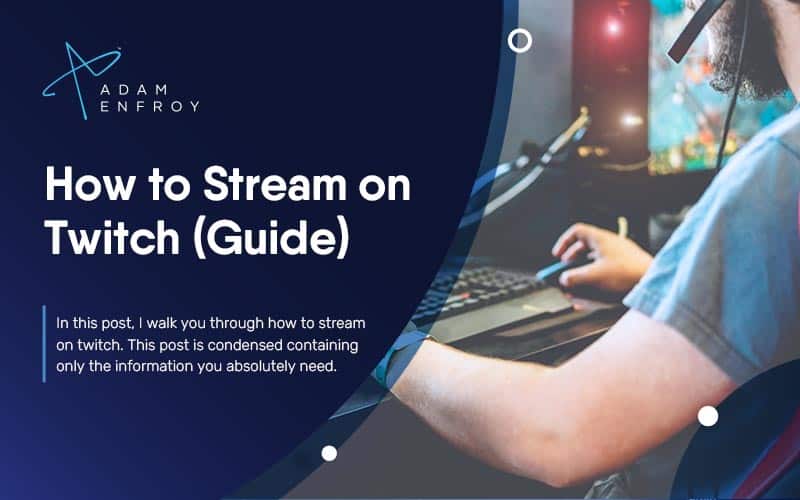The 4 Best Low-Cost Business Ideas With High Profit You Can Start Today

Have you ever thought about starting a business?
Maybe you want more time freedom so you can set your own schedule.
Maybe you want to escape that annoying boss who loves telling you what to do.
Or you simply want to fulfill your potential and make a difference in the world.
Being in control of your life is fantastic. At the same time, the possibility of starting a business and NOT MAKING MONEY (or even worse losing it all) might have stopped you in your tracks one too many times.
However, a proven business model makes all the difference—especially if it’s low-cost to start with high-profit potential.
Being part of a successful team that runs an online blog and sells an online course, I’m kind of biased towards an internet, content-based business model. However, I didn’t want to make that the sole focus of this post, so I included a couple of offline business ideas you might want to consider too.
In this post, I’ll show you:
- Case studies of successful businesses (both online and offline)
- The proven steps to start each business
- Startup costs and profit potential
- Key skills you need to have
- And much more
If you’re on the fence about taking the leap and becoming a business owner, this might just be the post to help you decide.
Why simple ideas are often the best ideas
Einstein once said (paraphrasing): Simplicity is genius.
Simple business ideas mean they’re easy to understand and execute. You don’t need complex strategies or special skills.
Quick disclaimer: Simple doesn’t mean easy.
You still have to put in the hours and make things happen—especially if you want to find inexpensive ways to start your business.
Here are my top 4 low-cost business ideas that generate a high profit:
- Start an online blog
- Run a cleaning service
- Sell online courses
- Flipping assets on Facebook Marketplace
If you’re interested in any specific idea, click the link above and jump directly to the appropriate section.
1. Start An Online Blog
| Profit Potential: Monthly Profit Potential (after 1+ years) $10k – $15k Startup Costs: Total Startup Costs $13 – $385 Monthly Operating Costs $3 – $310 Startup Costs Breakdown: Domain Name $10 – $15/year Web Hosting $3 – $10/month Blog Design/Theme $0 (Free) – $60 Content Creation $0 (DIY) – $100/post Miscellaneous Tools $0 – $300/month |
Writing a post about low-cost business ideas without mentioning blogging is like eating a chocolate chip cookie without the chips.
Starting a blog can be a great low-cost business with a HUGE upside potential. When you have an opinion about a topic you want to share with others, a blog gives you that option.
And the great news is that no matter what the topic is, others are likely interested in your thoughts.
The question you need to answer is, “How do I find MY people?” You won’t gain much traction if you create content no one consumes. Your words will get lost amongst the billions of pages online.
If you want to make money blogging, you must understand:
- Why someone would come to your site
- How to get the person to read your content once they’re there
- How to get them to keep reading till the end AND
- How to get the person to take the action you want
I understand that this might sound like a lot. However, if you can communicate in real life (and people generally understand you), chances are you’re already a blogger in the making.
You simply need to use this communicative approach when creating blog content.
Who Is Blogging Not For?
If you’re not willing to stand behind the “brand of you”, chances are an online blog won’t give you the results you’re expecting.
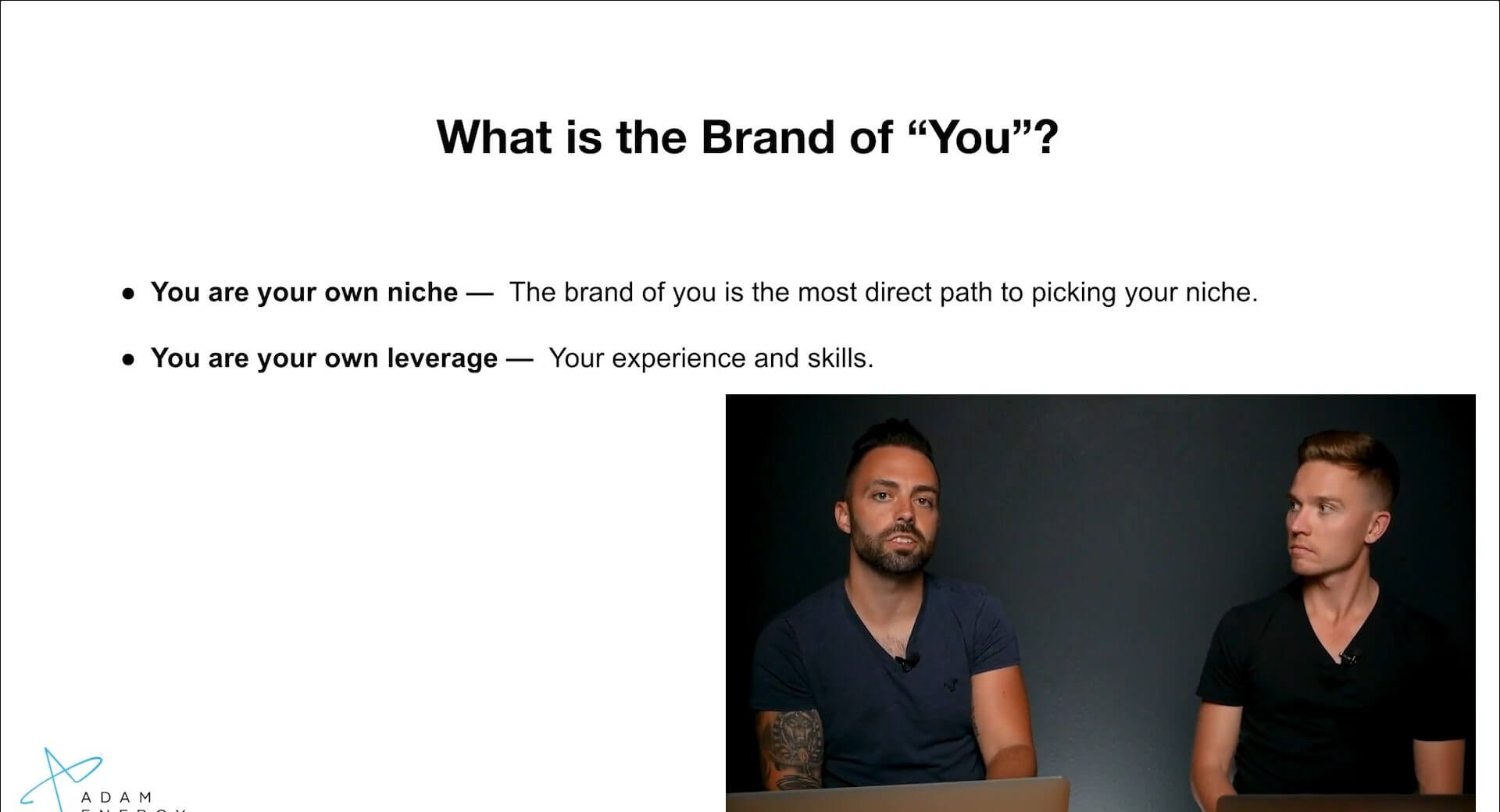
Nowadays, people do business with other people. Being willing to share parts of your life, what makes you tick, and being vulnerable to others’ judgments are key. These qualities are part and parcel of a successful online blogger’s journey.
People want to connect with, know, like, and trust others more than ever. Having a faceless online brand is something that no longer works.
To succeed as an online blogger, you must also be open-minded. Getting people to find your blog on search engines, clicking through, and consuming content isn’t easy.
It takes effort to understand what’s really happening with those who visit your site and the questions they need answered.
While AI writing tools can help, anyone can use these tools nowadays. Think about this question: “What value can I provide that no one else can?”. Unless you have a clear answer, you might find blogging life difficult.
You should also be somewhat technical. Setting up your blog on WordPress, installing the necessary plugins, choosing the right theme, and dealing with potential ongoing challenges might require research. If you’re a person who hates tech, an online blog might not be the right business for you.
Further Reading: Here’s a list of things Adam wished he knew before starting this blog. It might help you decide if it’s the right fit for you.
Case Studies
In case you’re not aware, AdamEnfroy.com isn’t just a blog. It’s a business that offers one of the best courses (if I may say so myself) about starting and running a successful online business.
Here are examples of successful students (now promoted to coaches) who have gone through Adam Enfroy’s Blog Growth Engine course.
EddyBalle.com
“A few years back, I would have laughed if someone told me blogging could be a real job. But in 2021, I took a leap of faith and enrolled in an affiliate marketing course. That was the start of my blogging adventure.”
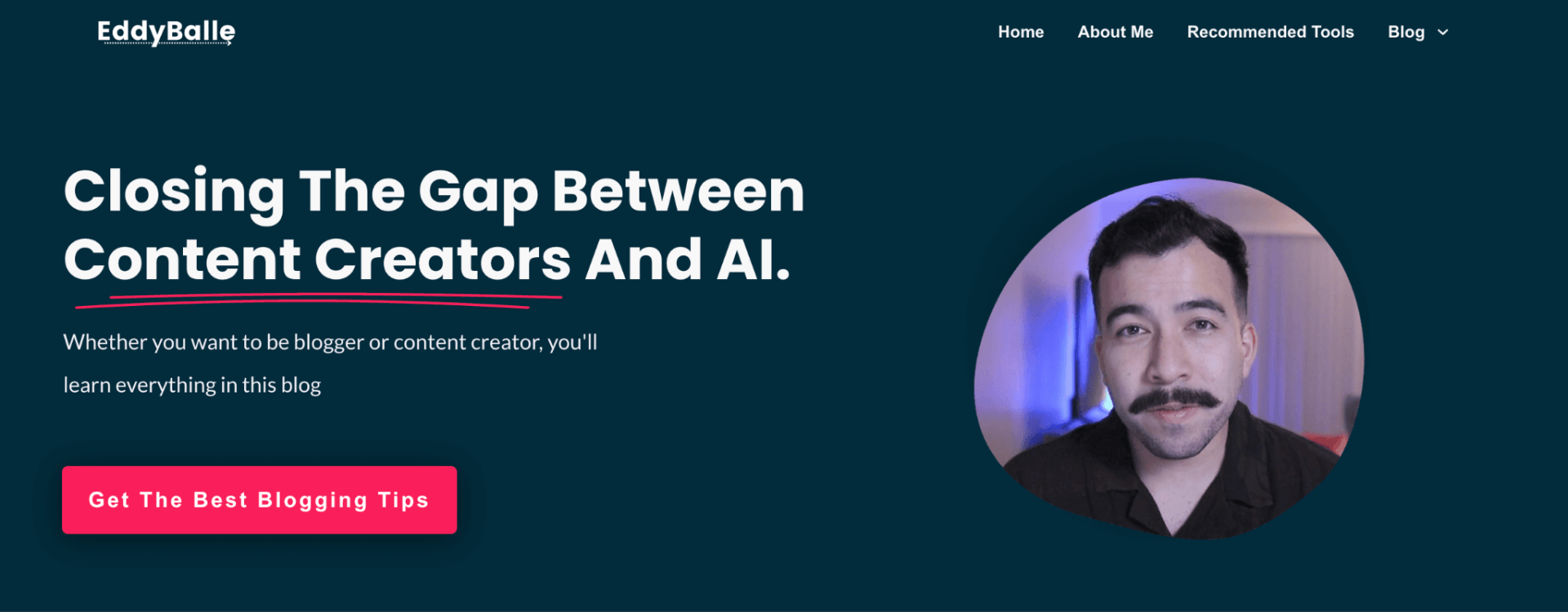
When Eddy started his blogging journey, he was skeptical. He didn’t think blogging could become a full-time career—until he took the first step. In his post on how blogging changed his life, he recalls how starting blogging was like joining a big family.
He first started seeing some small wins with affiliate sales. He took this as a sign that he was on the right track. That said, blogging hasn’t always been easy. Coming up with new blog ideas is challenging. Figuring out SEO isn’t a walk in the park. The great news is that he has always had a ‘figure it out’ attitude.
As time went on, he found himself helping other bloggers. People started to notice.
One of these people was Adam Enfroy. He saw Eddy’s success and started exploring working together.
When it comes to Eddy’s blogging journey, he can now generate thousands of clicks to his programs of choice. These clicks are responsible for generating affiliate commissions that help Eddy live the life he wants.

Today, Eddy is one of the top coaches in Blog Growth Engine. He helps students become better bloggers with cutting-edge information updated inside the course.
Marcos Isaias
Not all success stories happen overnight. Some of the most inspiring journeys involve persistence, determination, and a relentless pursuit of one’s goals. Meet Marcos, a remarkable individual who transformed his blogging journey into a profitable online business.
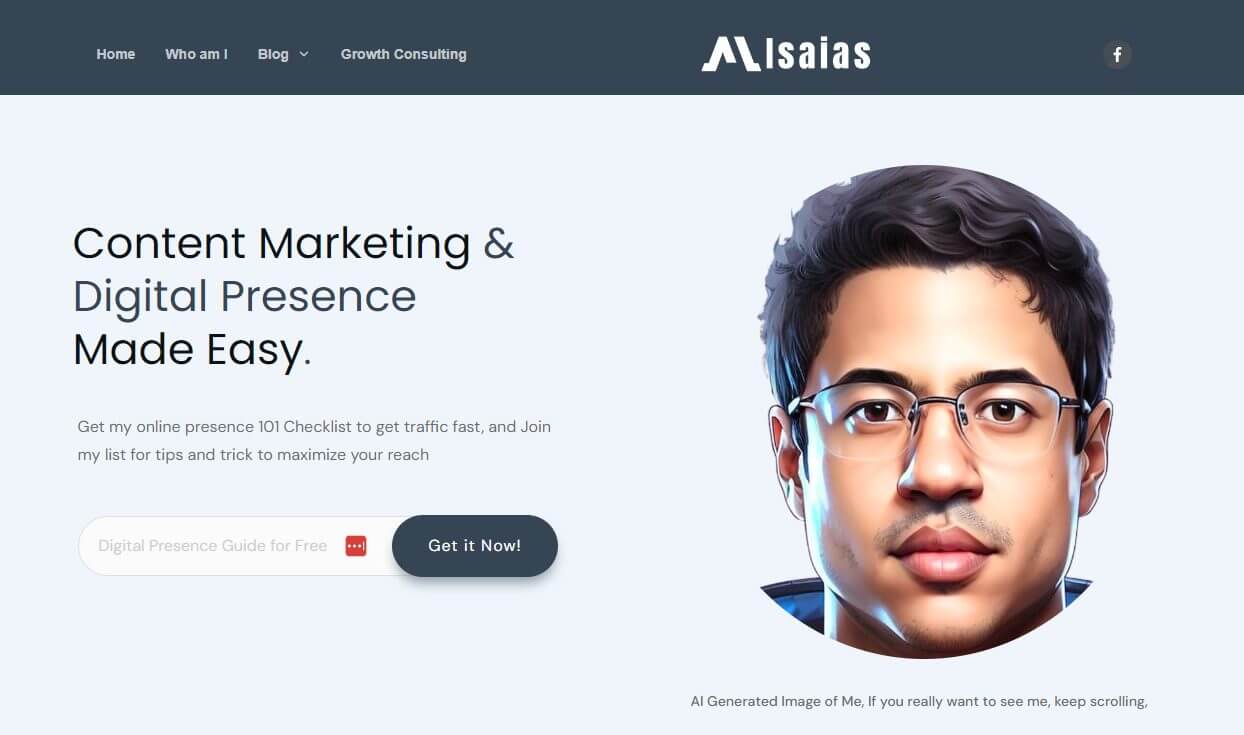
Marcos runs Misaias.com, a blog that revolves around the topic of content marketing. His story shows that success in blogging doesn’t happen overnight.
He began his blogging journey about two years ago, not as an expert writer or a digital marketing pro, but as an ordinary person with a full-time job and family responsibilities.
At the start, Marcos didn’t achieve immediate success. He didn’t have the writing skills of a pro, the SEO tricks, or the unbreakable work ethic of an experienced blogger. However, he had one crucial trait—he never gave up.
Marcos kept going even when his blog’s ranking was at the bottom and traffic was almost nonexistent.
It wasn’t until September of the second year that Marcos began to see real results. After nearly two years of blogging, he earned commissions and made a steady monthly income of $3,000 to $4,000. His blog practically ran on its own, despite challenges like Google algorithm updates.
But Marcos’s success didn’t stop there. Through affiliate marketing, sponsored posts, and collaborations, he has continued progressing (and increasing his income).
Here is one of of several affiliate income streams Marcos has:

In Marcos’s own words, “Don’t quit. You’re already here. You’ve felt the pain. PUSH through it (Persist Until Something Happens).” He encourages new bloggers to nurture their minds, refine their skills, and stay persistent, even if results take time.
Marcos Isaias’s journey proves that you can turn your blog into a profitable venture with dedication, patience, and the right approach. His story reminds us that blogging success is achievable, even for beginners.
Marcos is now another successful student-turned-coach inside our Blog Growth Engine course.
Becoming A Successful Blogger
Here are the steps to take when starting your first blog.
1. Research and choose a niche
While you might be tempted to start a blog that speaks about everything under the sun, this would be a mistake. Been there, tried that. Didn’t get anywhere!
If you try to speak to everyone, you speak to no one.
Instead, focus on a specific niche. The three big niches are:
- Health
- Wealth
- Relationships
Generally, people want to get better in one or more of these three areas.
So, how do you research the niche to go for?
I like to approach this from two angles:
- Your own expertise
- What people are searching for
The first one is based on your life experiences.
Which area do you feel you have value to offer others?
What experiences have you gone through that would make your thoughts on the topic valuable?
It doesn’t have to all be sunshine and rainbows, either. Your bad experience can be a bright light for those going through tough times. Don’t discredit any experiences you might have, even if they might be negative.
Here’s a snippet of text from Adam’s About Me page. In it, he talks about how perfectionism and self-doubt made him quit repeatedly (before finding success).
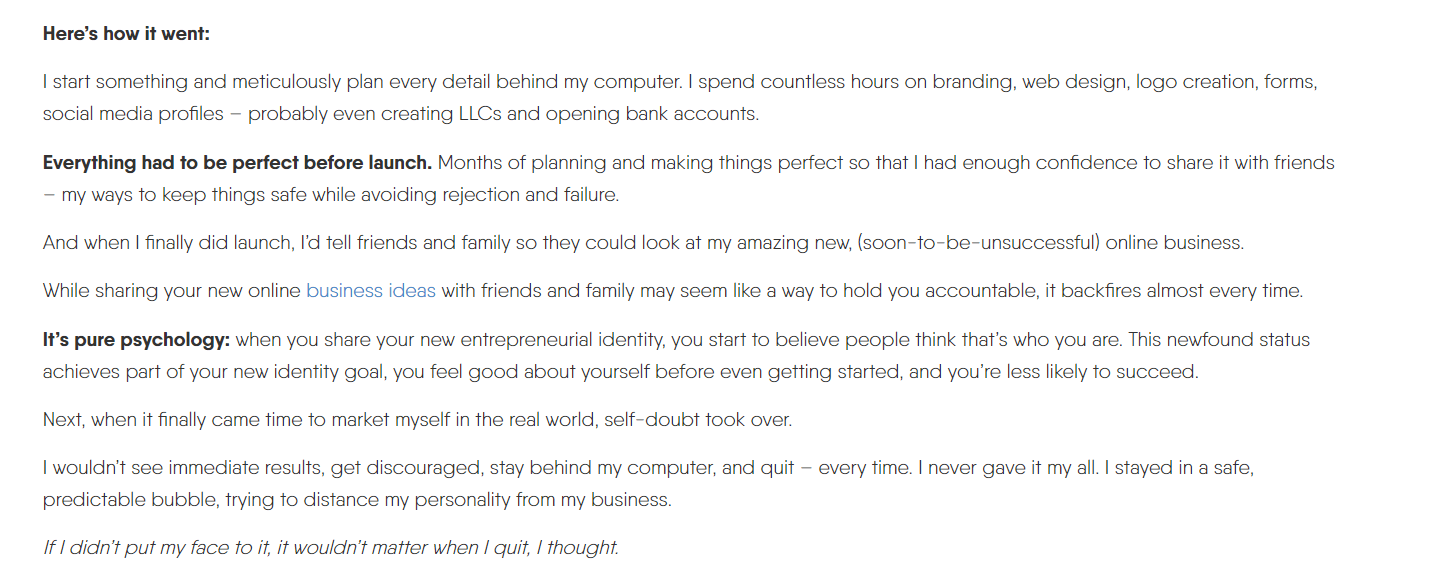
You can also look at this from a “passion” point of view. Speaking about things you enjoy doing is always easier than discussing things you don’t.
However, another disclaimer here: You DON’T have to talk about your passions to make money.
Plenty of blogs are run by people who write about topics they don’t particularly care for, but do it in a way that makes it interesting. Your audience finding value in what you’re writing is all that matters.
The second angle relies on people’s searches, i.e., search engine optimization (SEO). You can know which topics to base your blog around by using SEO tools.
Understanding how a tool like Ahrefs works helps you get data you can use to make important decisions about your content.

The key metrics to understand here are:
- Search volume
- Keyword difficulty
- Trends
Search volume shows you how many people are searching for a keyword every month. Ideally, you want your broad topic to get lots of searches. You can always niche down further as you understand which content resonates with your audience the most.
Next, you need to understand keyword difficulty. There’s no point in going for a keyword that’s impossible to rank for. Your blog will end up on the pages of Google that no one ever clicks on.
Let’s say I’m interested in “baking cookies”.

There are around 4.4 thousand people searching for the topic every month. However, it’s super tough to rank for these keywords.
But what if I’m interested in baking cookies and air fryers?

In this case, it’s much easier to rank for a keyword like “baking cookies in an air fryer”. While there isn’t as much search volume as the first keyword, there’s still a good amount of volume to work with.
Here’s a much more in-depth look at keyword research:
Trends are also important. If a topic was popular a few years ago but no longer is, that’s not good. You’ll end up spending time and resources creating content that no one is interested in— both in the short and potentially long-term future.
A good search on Google Trends shows this graph:
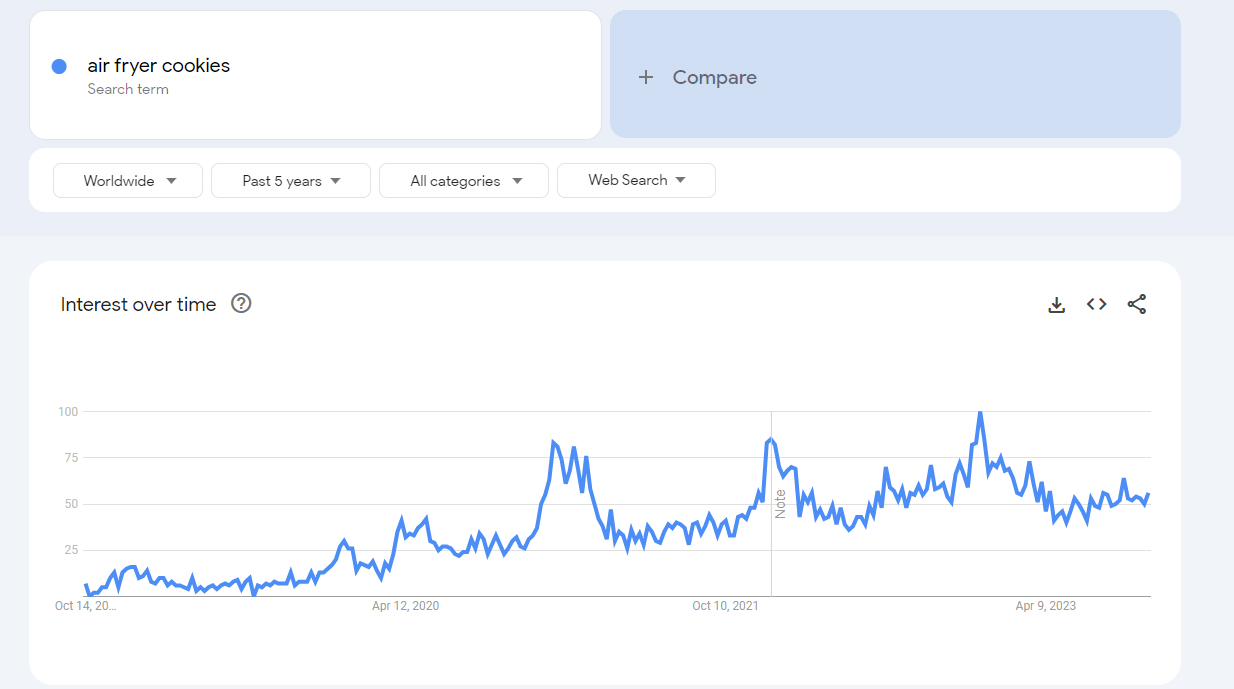
The trend has been increasing over the last few years. You might be onto something if you:
- Love cookies and air fryers
- And decide to research this further.
Here’s more information on how to pick a niche:
2. Set up a blog using WordPress
Once you know what your blog is going to be about, you’ll need to set up your blog. This is the first of a few technical parts.
Firstly, you’ll need to buy a domain. Head over to your favorite domain registrar and pick a name that fits your brand. The simpler the better. Make sure it’s easy to remember and type in.
Here’s how to buy and register a domain at GoDaddy:
Then, choose your hosting. Hosting gives you the space on which your site will live online. Here are our favorite online hosting providers.
Next up, you’ll install WordPress. Many hosting providers make this process as easy as one-click. Just follow your hosting provider’s instructions and your blog will be online in a few short moments. Technically, you’re ready to receive site visitors.
Here’s how to buy Bluehost hosting and set up WordPress:
3. Find and install plugins to add features
Plugins make your blog functional. While you can learn coding and use this knowledge to code your way around problems, there’s a much better way of doing things. Plugins are the answers.
There are WordPress plugins for pretty much everything you can think of. Need a plugin for SEO, analytics, contact forms, or social media sharing? There’s a plugin for all of those.
Head over to the WordPress plugin section for more information. Plenty of free plugins will get you started, but paid ones might offer a more specific solution. This might be something you explore in your blog’s future.
Want a roundup of the best WordPress plugins today? Here you go:
4. Select a theme that best fits your needs
If you want to make a lasting impression on your visitors, you need to choose a professional-looking theme that reflects your blog’s personality.
Whether you’re going for a formal look or something more playful and colorful, you can choose from plenty of great themes.
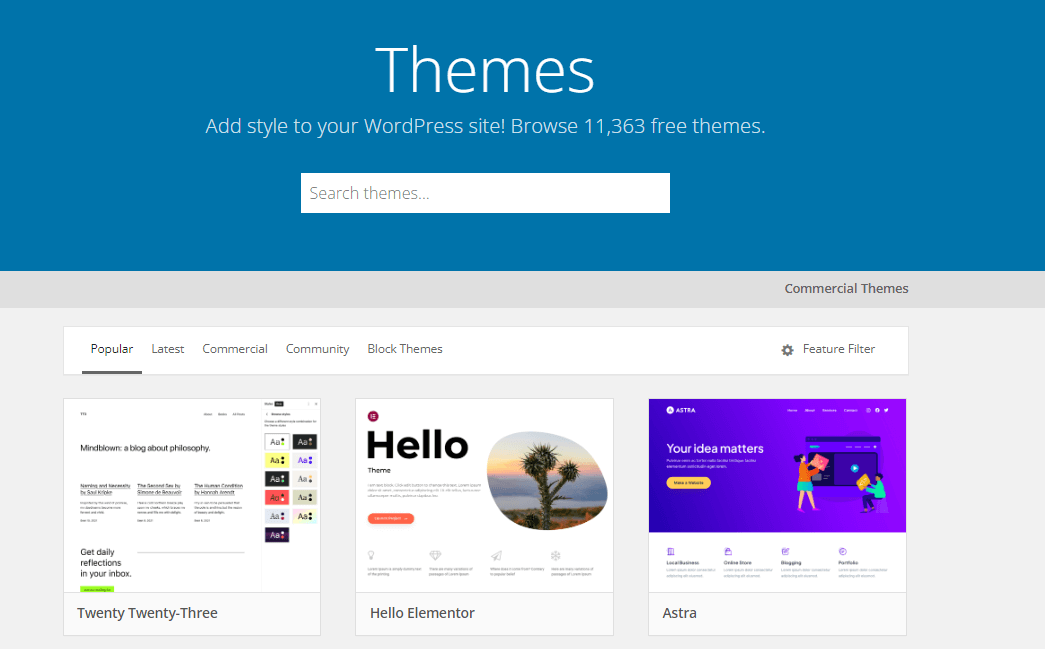
Browse the WordPress theme directory for inspiration. You can also hire a designer if you want something specific that you can’t find as a preset but in my experience, a preset theme is more than enough to get started.
5. Create content, promote it, and build an audience
Now, let’s talk about content. To put it bluntly, without (the right type of) content, there’s no blog.
Let’s define “the right content” by turning the discussion back to value and providing a concrete example.
Let’s say you’re writing a post about the best tablets to read on. Most people will simply list the top X number of tablets, providing some features and potentially some benefits to using each one of them, and then fill their post with affiliate links.
This tactic used to work a few years ago—it doesn’t now. Both people and search engines require more than that. You need to make your content stand out and show people exactly why they should consider your solutions.
If you’re making recommendations, discuss your experience with the tablets.
Mention the specifics of what you like and what you don’t. Don’t be afraid to mention specific situations where you find your tablet useful and the instances where you just want to throw it in the trash.
“Zoom In To Zoom Out” is a phrase a mentor of mine told me a few weeks ago. The more specific you make your content, the more value you provide your readers. Moreover, the more you speak directly to your audience (i.e. the PERSON reading your content) the better.
Moreover, this is the type of content that people will promote for you. Here’s one way of looking at content creation:
- Option 1: You create quick, fluffy content that doesn’t provide much value. You then spend all your time promoting it to anyone who might find it helpful. This is the “publish-quickly-and-then-pray” method.
- Option 2: You can create content that goes into great detail. This content explores real problems that people are facing and provides them with solutions to their problems. You speak about your experiences (good or bad) and how these experiences can help others solve their problems.
Which one makes the most sense?
6. Monetize the blog
After you start getting people to visit your website, it’s time to make money.
Didn’t forget about that one, did you?
Here’s the kicker. Imagine you go to your local bank and attempt to withdraw money but your balance is $0. You’re not going to get very far, right?
The same concept applies to blogging beginners who ask for stuff too soon. When you ask people to do something for you (i.e., buy your own products/affiliate products/click on an external link/etc.), you withdraw from your “trust bank”.
To successfully withdraw, you need to have a “positive trust balance” with your readers. How do you build this up? Have a guess!
The answer is: By providing valuable content. Yes, it goes back to VALUE.
Once you start getting traction (i.e., people visiting your site, commenting on your post, and signing up for your email newsletter), you can make your requests. However, do not “overdraw” your balance. You want to ensure you’re still providing value when making your asks.
Always consider that people are asking, “What’s in it for me?”. Being selfish creatures (said with love of course), people care about themselves first. Keep this in mind and address this with every piece of content you create.
7. Track performance and make adjustments accordingly
Tracking the right metrics helps you know what’s working for your blog and what’s not.
You can’t just keep publishing content and hoping things work out. What you track, grows. What you don’t, doesn’t. Simple.
It’s crucial to track metrics like:
- Website visitors
- Time spent on page
- People clicking on specific links
Using the right tracking tools will make your blogging life easier. Start with a simple solution and then add more complexity as time goes by.
However, tracking alone won’t increase your site traffic. You must take action based on the data that you’ve just collected.
For example, strive to improve your content if you find people coming to your site but not stick around. Maybe try a new hook. Consider adding more graphics or videos. It’s all about the value you give your readers.
If you see a lot of traffic but no conversions, look at the user experience and see if you can improve. Maybe the page takes too long to load, or your calls to action aren’t clear. Whatever it is, take action on your data and try to improve it.
Key Skills To A Successful Online Blog
Here are the skills you must have (or develop) to become a successful blogger:
Deep Audience Understanding
Recognize that your readers are seeking clear, actionable advice. If you have a digital marketing blog for beginners, don’t just discuss the importance of SEO. Instead, provide a step-by-step guide on how a beginner can optimize their first blog post for search engines.
Consistency
Commit to a posting schedule. If you promise a new article every Monday on “Monetizing Techniques for Blogs,” ensure that there’s fresh content on that topic waiting for your readers every Monday.
Basic Technical Know-how
Familiarize yourself with the blogging platform you choose. For example, if using WordPress, know how to create a blog post, insert images, add links, and adjust your SEO settings.
Don’t Be Afraid to Dig Deeper
Provide well-researched advice. If you suggest affiliate marketing as a revenue stream, cite successful case studies or offer a list of beginner-friendly affiliate programs.
Be Patient
Building a profitable blog doesn’t happen overnight. All top bloggers have been in the game for years, continually refining and improving their monetization strategies. It might be a bit of a cliche, but trusting the process is essential.
Stay on Top of Trends
Stay attuned to blogging trends. If there’s a surge in bloggers using Pinterest for traffic, or if Instagram influencer marketing is taking off, read up on the subject and see how to leverage it.
A Note On Affiliate Blogs
Affiliate marketing and online blogging are like bread and butter.
They go together very nicely. As you create helpful content that solves specific problems, this will (in turn) create further questions.
Being the creatures that we are, human beings always want to get to the next solution. In this case, affiliate products might just provide the needed answer.
Here’s an example.
Let’s say you write an informational post on how to fix a broken iPhone. You go into detail about what’s required to fix it. When someone finishes reading your post, they know the steps to follow to fix their broken phone.
The next problem? They don’t have the necessary supplies. That is a great opportunity to recommend an affiliate product. This comes in the form of a phone repair kit containing all the pieces needed in one convenient package.
When people buy the repair kit, they are happy because they can now have an iPhone that doesn’t look like it’s been run over by a truck.
You are also happy because you get a commission for the purchase.
That’s a win-win situation created by leveraging affiliate products. And it could be one of many ways to monetize your blog and increase revenue.
2. Run A Cleaning Service
| Profit Potential: Monthly Profit Potential (after 6 months) $2,000 – $5,000 Monthly Profit Potential (after 1-2 years) $7k – $15k Startup Cost: Total Startup Costs $850 – $4,000 Monthly Operating Costs $0 – $700 Startup Costs Breakdown: Business License $50 – $300 Cleaning Supplies $100 – $500 Marketing & Advertising $0 – $500/month Uniforms/Branding $0 – $200 Insurance $500 – $2,000/year Miscellaneous Tools/Equipment $200 – $1,000 |
Let’s explore a low-cost business idea that has a high probability of making a quick profit.
Have you ever thought about what goes into a house cleaning service?
While many companies offer such services, the main problems customers face generally involve:
- The service provided (the cleaning isn’t done well)
- The customer service (it takes a long time to get an answer)
- The cost (it’s too expensive)
As a result, starting a cleaning service could be an opportunity to fill a gap in the market.
Running a cleaning service involves being the middleman (or woman) between the customer and the cleaning person.
As a business owner, you don’t want to provide the service yourself.
Instead, you want to find the right people to do it while focusing on the things that move the needle—finding clients and ensuring they get excellent service and refer more people.
Don’t run a cleaning service if…
…attention to detail isn’t your strong suit.
From the moment you hire people to the moment you reach out to customers to review whether a job was well done, attention to detail is key.
In an industry where many just want to get the job done (so they move on to the next one), being aware of EVERY TINY DETAIL will be the differentiator.

People want (and expect) cleaners to treat their house like it’s their own. They want the most return on their money and to know their house will be spotless after the cleaners leave.
As the business owner, you’ll need to hire people who will clean houses as if they were running their own business.
You also want to hire people who will strive to meet and exceed high standards of cleanliness. Training them on all the little details that make a big difference is essential.
Details such as:
- how to properly dust
- wipe down surfaces
- polish furniture
- sanitize bathrooms
Extra points if you can find someone with experience who can also train people for you.
Case Studies
Here are some examples of people who started a successful cleaning service.
Think Maids
Christopher Schwab, a college student in Washington, D.C., noticed some big issues in the cleaning industry. Instead of just observing, he decided to make a change. He started Think Maids, a cleaning service that put the customer first.
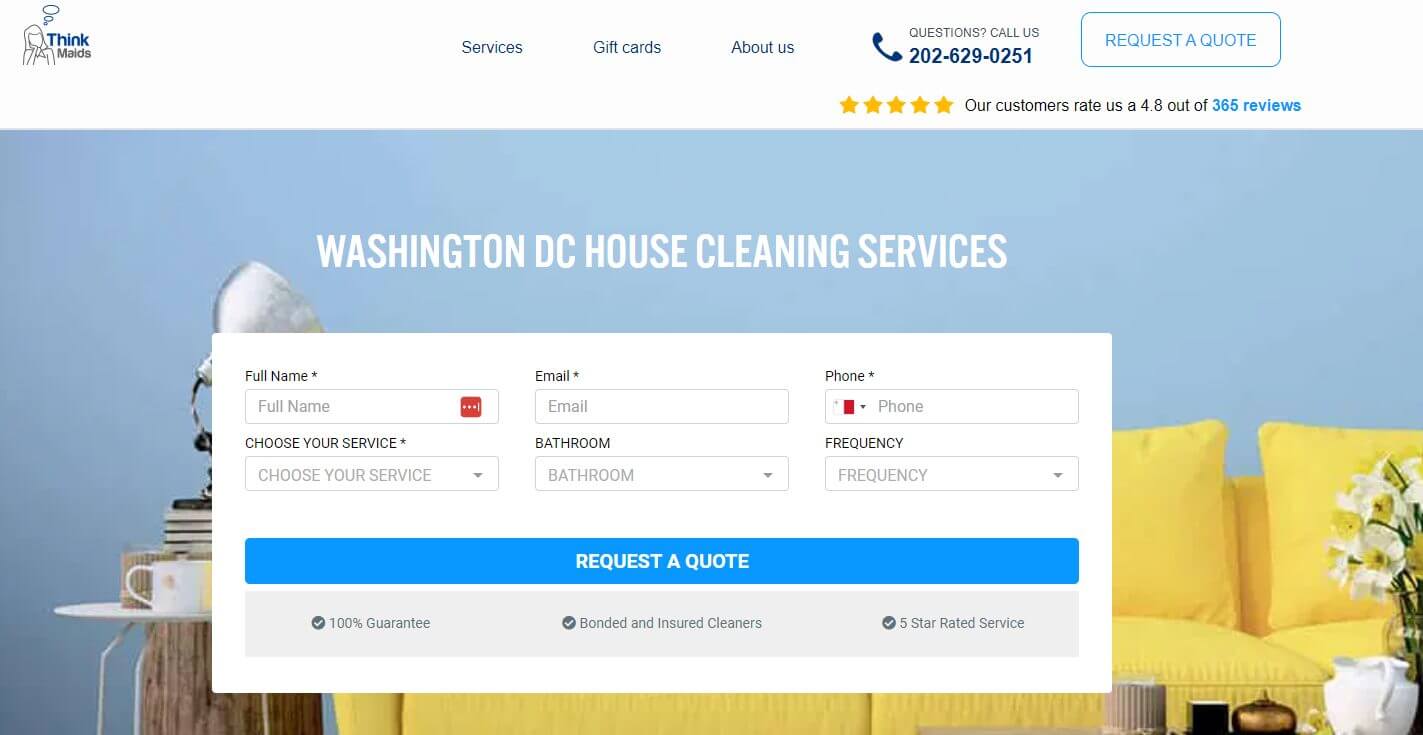
Unlike many other cleaning services, Think Maids made things easy for their customers. They introduced simple online booking, allowed easy changes to appointments, and let customers give special cleaning instructions. What stood out the most was their quick response time.
Whether by phone, email, or text, they aimed to reply within just 3-5 minutes.
This focus on customer service didn’t just make clients happy and generate repeat business for the company, it benefited the owner too.
So what can owning a cleaning business do for you?
Schwab shared that the best part of his journey was the freedom it gave him. By focusing on making his business efficient, he could even take time off, like taking a 10-day trip to Japan without worrying about business.
So how did this happen?
It all goes back to the value you provide your customers. Think Maids was able to differentiate itself from the competition by offering excellent customer service and a streamlined booking process.
In the end, Think Maids isn’t just about cleaning homes. They’re about creating spaces people can relax in and enjoy, and they take immense pride in that.
They also allow their customers to win time – a factor their clients value.
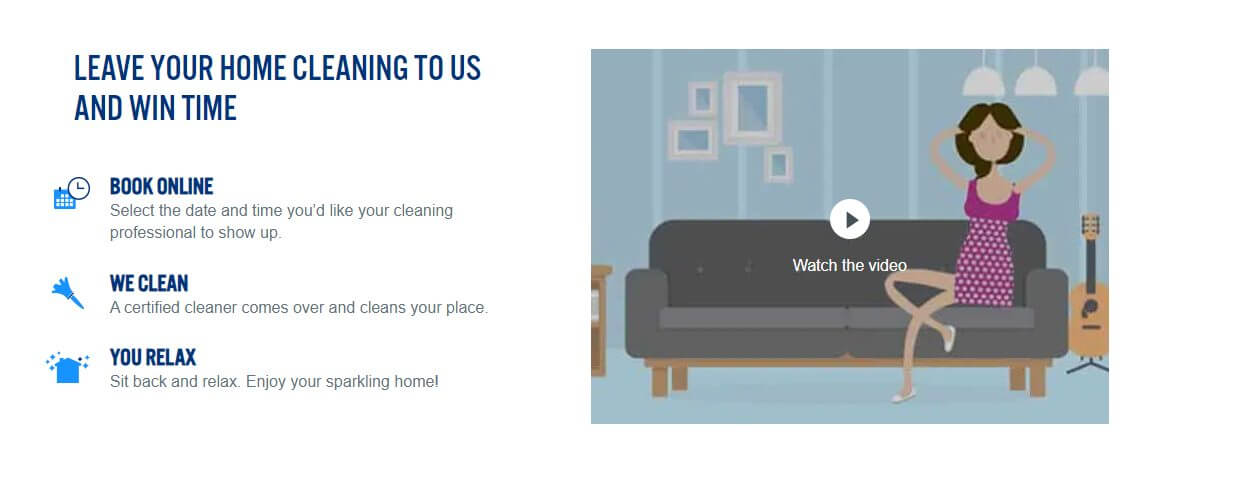
So, ask yourself:
How can you apply this to your own business? How can you focus on providing so much value to your customers that they can’t help but come back?
The BBQ Cleaner
In 2005, Jeffrey Krentzman began cleaning BBQ grills in northern New Jersey. He recognized the potential of his unique cleaning system and founded The BBQ Cleaner in 2009.
Today, the business boasts over 270 locations across the U.S., making it one of the leading grill-cleaning business opportunities in the nation.
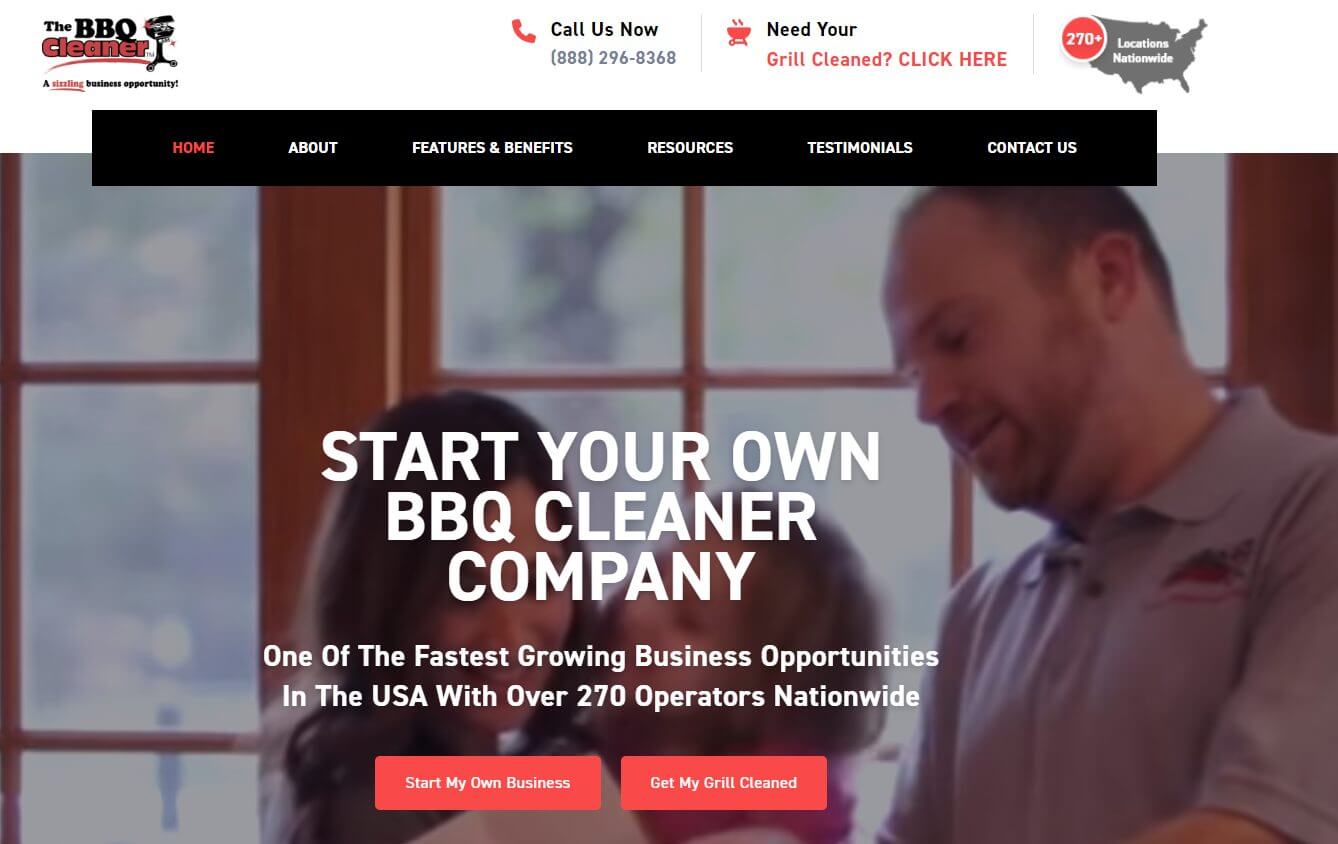
Despite creating his way of cleaning and providing excellent local service, turning that into a process and making it a big-time national name wasn’t easy.
Here’s how he tackled these challenges:
- Choosing a Superstar Cleaning Method: Jeffrey didn’t just pick any cleaning method. He went for the Ovenu system, known as the superstar of cleaning methods.
- A Different Kind of Business Model: Jeffrey thought, “Why not let the operators have a bit more freedom instead of going the usual franchise route?” So, he gave them a business opportunity where they could set their prices and hours. It’s like giving them the keys to their own BBQ-cleaning kingdom!
- All About Support: Jeffrey’s not the kind of guy to leave his people hanging. He made sure every operator had the best training, top-tier cleaning products, and a helpline for any questions. It’s like having a safety net, ensuring top-quality service, and ensuring the operators are part of a big, supportive family.
- Marketing Magic: With some killer marketing materials, Jeffrey made The BBQ Cleaner the name everyone thinks of when they want their grill to shine. It’s all about being the first name that pops into your head when you think of BBQ cleaning.
So, in a nutshell, Jeffrey saw challenges as opportunities. He was able to spot the gap in the market and recognize unmet needs. He saw the demand for grill cleaning and filled it. He also used proven systems to scale his business model effectively.
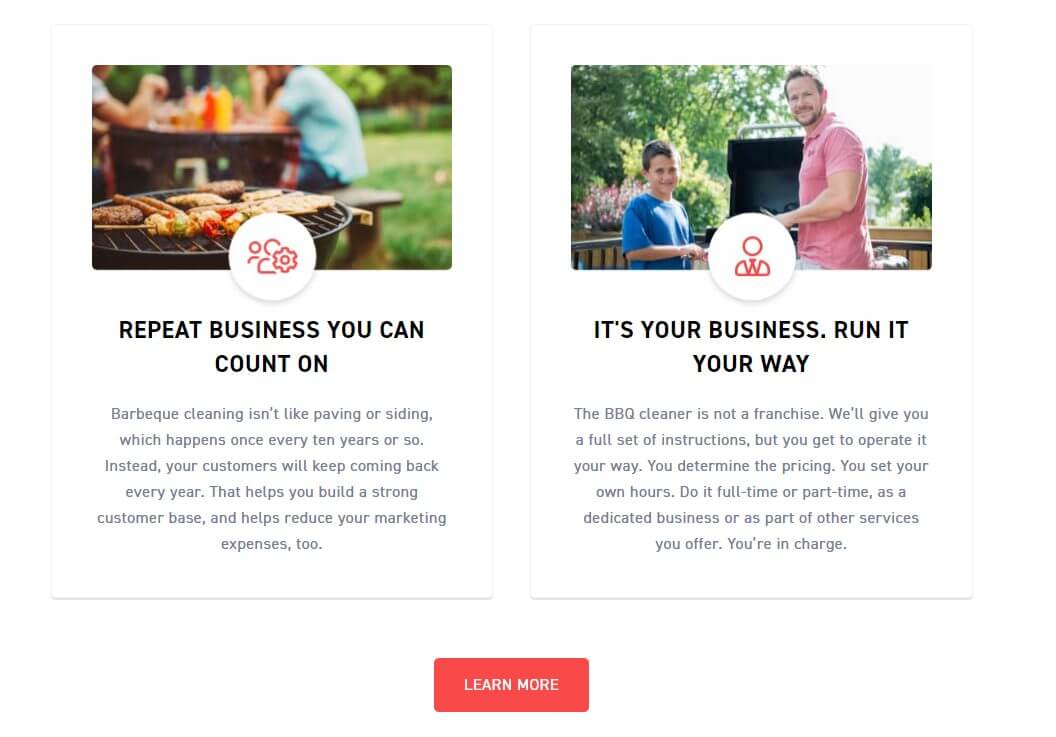
My question to you: How can you use these same tactics to grow your business? Which aspects do you think would be the most beneficial for your business success? Let me know in the comments below.
The process of starting a cleaning service
Here are the steps needed to get a cleaning service off the ground:
Find out what services you would like to offer
Cleaning services can range from basic cleaning to more specialized services.
Here’s a breakdown of some of the basic services you may offer:
- Vacuuming
- Dusting
- Window cleaning
- Kitchen and bathroom deep cleaning
- Laundry services
Some of the more advanced ones might include:
- Carpet cleaning
- Upholstery cleaning
- Pressure washing
- Wall and floor scrubbing

The great news is that you don’t have to start by offering all the abovementioned services. You can find people who specialize in one type of service and build up your client base from there.
For example, if your people can do carpet cleaning, start with that. As you build up your client base and become more experienced, you can then expand the services you offer.
Create a website and social media accounts
Even if you offer an offline service, it pays to have an online presence. People need to be able to find you and get more information about what services you offer, so if you’re not on the internet yet, now is the time to start.
Create a website that showcases your services. List out any special offers or packages that you have available. Ensure that when someone lands on your site, the messaging is clear. If people immediately know what steps to take, they’re more likely to take them.
In addition, create social media accounts where potential people can follow what you do. It’s also a great opportunity to ask clients to review your work on your social media pages. This helps boost your online presence.

Image credit: thinkmaids.com
Moreover, don’t be afraid to create content. Informing potential clients about WHY your services will benefit them will help you stand out from the rest.
Get some clients
You can’t make any profit if you don’t have clients. You might have the best business idea in the world, but nothing will happen unless people pay for your service.
Start by contacting your immediate network and ask them if they know someone who can benefit from your cleaning services. You could even start by offering your services for free to get the ball rolling. Chances are that people will want to keep working with you if you deliver excellent service.
First impressions count.
After you exhaust your personal network, you will start getting referrals (if you’ve provided a great service). You might also want to focus on advertising channels like:
- local influencers
- running paid ads on your website
- direct mail campaigns
- email marketing
- Cold-calling potential clients
The best channel depends on your business type and the marketing budget behind it.
Make it easy for people to get in touch
Communication is key. Whether someone has a question or wants to make a complaint, they need to be able to reach you quickly.
You will lose business if people can’t get in touch on their first attempt. One of the best ways to ensure this happens? Hire someone to install a chatbot on your website (allowing people to ‘chat’ with you directly from your site).
Advanced Steps
Here are a few additional steps to consider.
Research and understand the regulations in your area
Rules may vary depending on where you operate your business. Consider any safety standards or requirements that need to be met by your cleaners.
If you’re offering specific types of cleaning—especially in the case of commercial buildings, the OHSA (Occupational Health and Safety Administration) may have regulations that must be followed.
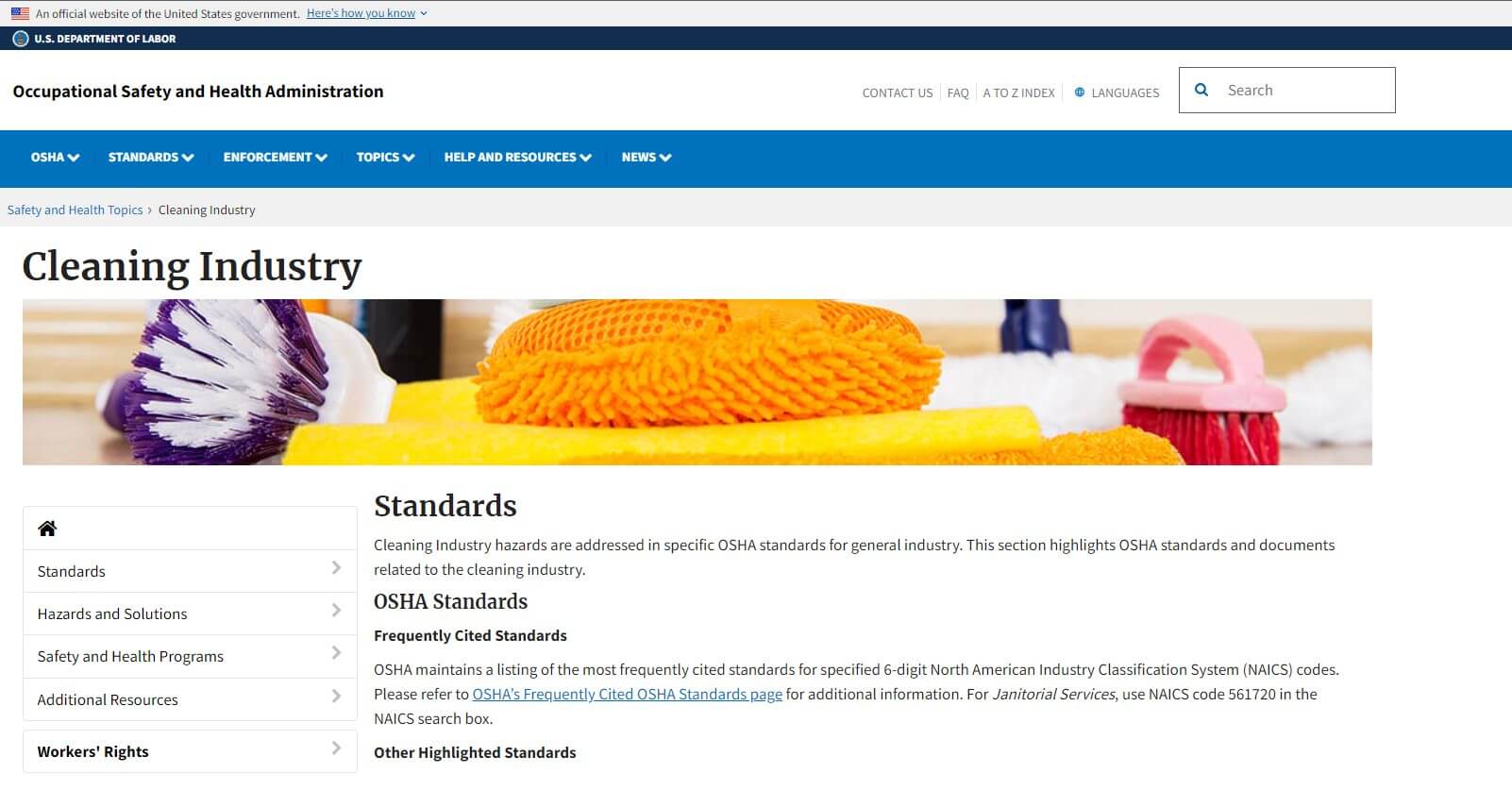
Make sure you comply with such standards.
Take Out Insurance
Eventually, you might also want cleaning insurance for your cleaning business. The last thing you want is for you to have to pay out of pocket for any accidental damage or injuries.
Professional liability insurance and workers’ compensation insurance are two types of policies you should consider. Insurance companies can advise you on what type of coverage you should get and how much it will cost.
Key Skills For A Successful Cleaning Business
Here’s a list of key skills that you’ll need to succeed in the cleaning business.
|
Skill |
Description |
|---|---|
|
Customer Focus | Treat every client like a close friend. What if you remembered their birthdays or anniversaries and sent a personalized note and offered a discount? |
|
Time Management | Punctuality is respect. If an appointment is at 10 AM, aim to be there by 9:45 AM. Use tools like Google Calendar to set reminders and plan your day. |
|
Quality Work | Ensure thorough cleaning. For example, don’t just vacuum the surface; move furniture and clean it underneath. Use premium cleaning agents that are eco-friendly. |
|
Clear Communication | Keep communication open. If a client prefers lemon-scented cleaner over lavender, make a note of it. Always confirm appointments a day in advance. |
|
Problem-Solving | Address unexpected issues promptly. If a vase breaks during cleaning, inform the client immediately and offer compensation or a replacement. |
|
Training | Equip your team with the latest cleaning techniques. For instance, if there’s a new stain removal method, hold a workshop to teach it. |
|
Money Matters | Monitor expenses. If the price of cleaning supplies goes up, consider buying in bulk or finding an alternative supplier to keep costs down. |
|
Promote Smartly | Inform clients about new services. For example, if you’re introducing carpet cleaning, offer a discount to existing clients for the first month. |
|
Be Adaptable | Adapt to industry changes. If there’s a viral outbreak, offer specialized sanitization services and use recommended disinfectants. |
|
Stay Honest | Build trust with transparency. If a client is overcharged by mistake, refund the extra amount and offer a discount on their next service as a goodwill gesture. |
Integrating these skills with on-the-job practice will ensure short and long-term success.
Can You Do This With Other Services?
Yes, you can.
Just because I spoke about a cleaning service doesn’t mean you’re limited to JUST that type of business. From lawn care to snow removal, there are other service businesses you can start with minimal up-front costs.
Here are some other ideas:
- Pet sitting/dog walking
- Home organization services
- House painting services
- Pressure washing businesses
You’ll need to research the local market and see what services people in your area need. This will help you determine the best way to set up your business and what services you should offer.
3. Sell Online Courses
| Profit Potential: Monthly Profit Potential (after 6 months) $1,000 – $10,000 Monthly Profit Potential (after 1-2 years) $10k – $50k Startup Costs: Total Startup Costs $50 – $11,800 Monthly Operating Costs $0 – $100 Startup Costs Breakdown: Course Creation Software $0 (Free) – $500/year Video Recording Equipment $0 (DIY) – $5,000 Audio Recording Equipment $0 (DIY) – $1,000 Marketing & Advertising $0 – $1,000/month Website & Hosting $50 – $300/year Course Content Creation $0 (DIY) – $5,000 Payment Gateway Fees Varies (2-5% per transaction) |
Creating an online course doesn’t involve a lot of costs.
However, it does involve having real expertise in a subject matter. You generally gain this expertise over years of getting better at your craft.
You can’t just wake up one morning and create a course about something you felt semi-good at during the previous night’s dream. The market is saturated with those types of courses.
In a nutshell, it again goes back to providing value to the person taking the course.
The way I see it, this is great news. While technology allows everyone a level playing field when publishing courses online, the marketplace will then decide what’s valuable and what’s not with their wallet.
Another critical factor – the global e-learning industry has been on a consistent growth path for several years (and experts predict it will keep going).
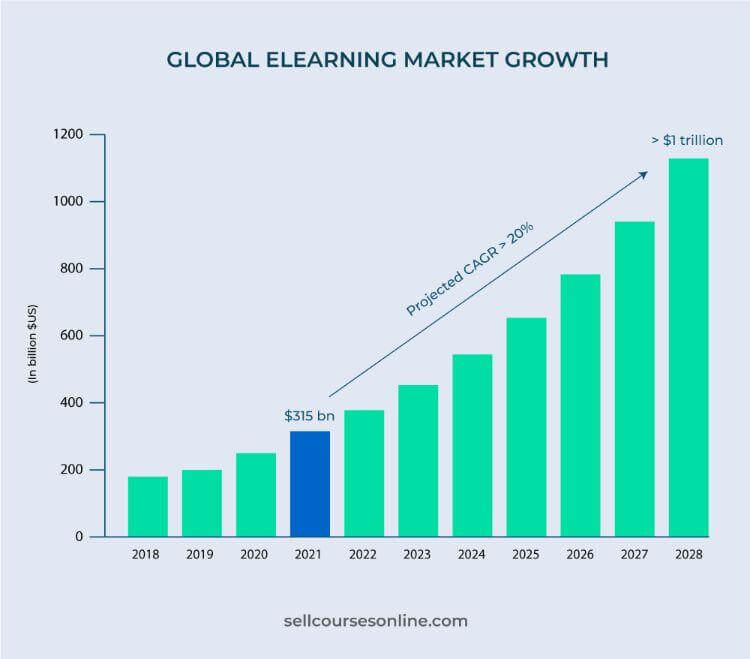
Image credit: sellcoursesonline.com
Who is an online course business for?
If you have knowledge that can improve people’s lives (i.e., make them more money, improve their relationships, improve their health, etc.), this might be the right business for you.
You can go as deep as you want within the three big niches I mentioned. The deeper you go (i.e., the more specific), the more you might be able to charge.
Here are a few examples within the main categories:
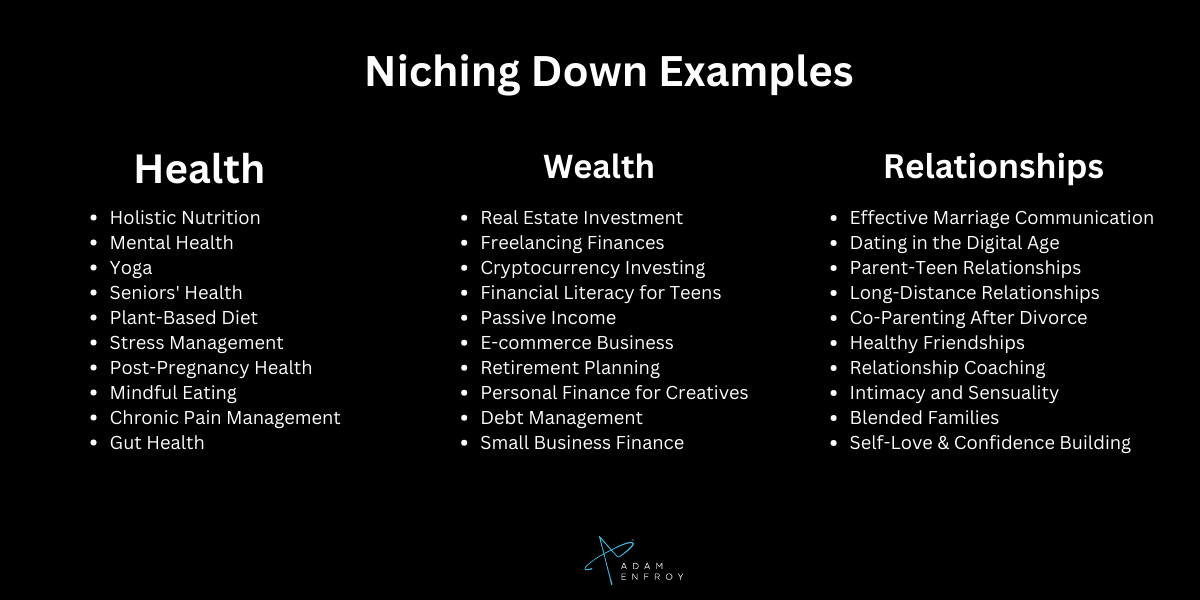
You can also niche down within the same category. For example:
- General course: time management
- More specific course: time management for accountants
- Super specific: time management for tax accountants working in public accounting
The final example is more valuable to its target audience. The downside is that your target audience will get smaller. However, this is generally not something you have to worry about too much. Especially when starting out, there will generally be enough people in your market to target.
Unless you’re going for some obscure niche (Horology or Cryptozoology anyone?), chances are you can find people whose problems you can solve.
Don’t create an online course…
If you:
- don’t have any valuable insights/expertise in the field you’re teaching
- are only creating a course to make money without caring much for your students/customers
- want to copy someone else’s course without adding anything of value
…then creating a successful online course probably won’t happen.
It takes dedication, effort, and time to be successful. The great news is that the profitability of an online course can be in the thousands of dollars, making that time and effort worthwhile.
Even better, you only have to create an online course once. Unlike a blog where you need to add new content consistently, the foundation of an online course generally doesn’t change much.
You might need to add new modules as time goes by to keep it relevant (if it’s more of a topical subject like the latest in social media marketing or clothes to wear THIS winter, etc.).
If you cater to an evergreen niche (think: cooking, yoga, productivity, or language learning), then this might not apply.
Case Studies of Successful Online Courses
Here are some examples of those who turned a successful online course into a money-making business.
The School of Calisthenics
The School of Calisthenics is an online course platform allowing people to dive into the world of bodyweight exercises.
In a short span of just one year, they attracted 40,000 users. Tim Stevenson (the brain behind the success story) had been a strength and conditioning coach for years.

But when he faced a challenge with his own shoulder, he turned to calisthenics. This exercise method not only helped him but also inspired him to share it with others. Teaming up with his buddy, Jacko, they launched the School of Calisthenics.
Their aim: They wanted to help others gain strength, move better, and enjoy bodyweight exercises.
The school’s success was quite quick. Right from the start, people loved it. In just the first month, over 2,500 students signed up. This growth came because happy students told their friends and the word spread quickly.
The team worked hard to make sure students had a great time learning. They figured out who would most enjoy their courses and contacted them. They also found the best ways to talk to and engage with these potential students.
The school then hosted its course on LearnWorlds, an online platform that helped it grow even more. The platform made it easy to provide their students with the best learning experience.
Students could use their phones to access courses, which was handy for those practicing at home or the gym.

From a personal challenge to a booming online school, the School of Calisthenics has come a long way. Their story is a testament to passion, hard work, and the right choices.
Can you think of any other ways you can turn a personal challenge into a successful business?
Let me know in the comments below!
Writing Revolt
Jorden Makelle turned a tough moment in her life into a big win. The big moment? She lost her job on the same day her husband did.
As a result, she started building her business. Now, Writing Revolt earns $300K a year.
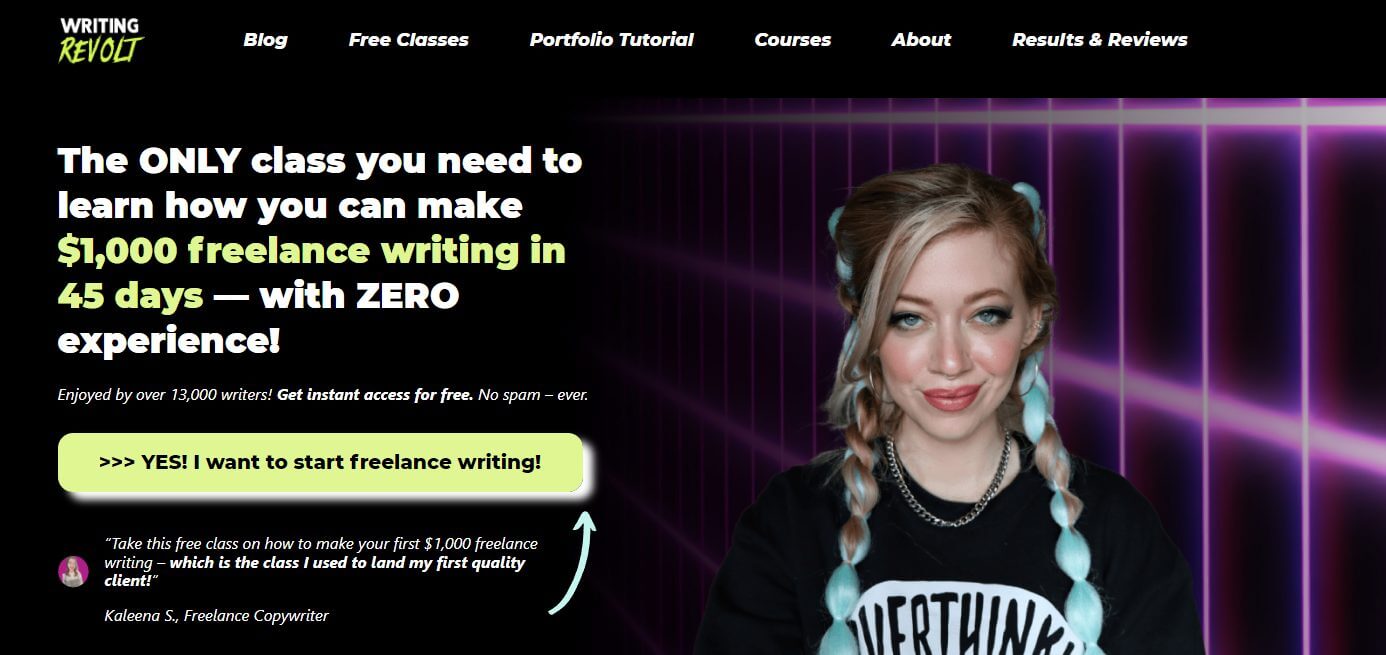
So how did that happen?
After she lost her job, Jorden didn’t waste time. In just four months, she was earning $5,000 a month from writing. She turned her dream of writing from home into reality.
Her blog had a common enemy:

Definitely something that many blog writers might relate to—personally speaking, content mills and bidding sites aren’t fun to deal with.
But let’s focus on Jorden. Do you know what really made her dreams come true? She made a course called Killer Cold Emailing. This course taught others how to start writing emails like she did. Many people loved it and found it helpful.
As part of her online course, Jorden uses curiosity to get people to take the first step.

As a potential writer, taking a quick quiz will help you find your best writing niche. This is a problem that many writers run into when starting out. Knowing what to write about can go a long way to getting those writing wheels turning.
When you help people solve their problems, this creates new problems. In this case, once you know which niche to write about, what do you actually write?
And that is exactly the question her online course solves.
So, ask yourself:
What problems can you help people solve that will open up other problems? For example, can you help people write emails better, faster, and more efficiently? Can you help them build a website or create content? These are all questions to consider before building your own course.
Building an online course the right way
Here are the steps to successfully build, launch, and monetize your online course.
Pick a niche
Picking the right niche helps you with multiple things:
- Knowing who your target audience is
- Creating content your audience will find valuable
- Figuring out how you’ll promote your course
In this way, having an online course is similar to having a blog: no niche = you end up marketing to everyone = you market to no one.
Don’t do that!
Finding the intersection between things you love doing/speaking about, are an expert in, and topics that people will gladly pay money to learn is crucial.

Here are some questions you can ask yourself to start narrowing down your niche:
- What topics could I teach that people would pay for?
- Are there other courses on this topic?
- Why am I passionate about this topic, and why should others be interested?
- What other areas of expertise can I bring into this topic?
- How can I make this topic stand out from the competition?
Take the time to answer those questions, and you’ll better understand which niche you should focus on for your course.
Brainstorm your course content
With the above answer, you can now create draft modules for your content. Think about this as if you’re creating an outline for an article you’re writing.
You should have the building blocks to ensure you stay on topic and don’t repeat information. Doing so will decrease the value of your course.
At this stage, you can also consider the submodules that will go into each more extensive module of your course. It’s also important to evaluate the level of knowledge your students will generally have.
If you’re targeting beginners, you’ll want to explore the core concepts that make future modules easier to understand. Conversely, going for a more advanced audience means you make certain assumptions when teaching.
When brainstorming your course content, consider how you’ll deliver information:
- Are you going to record talking head videos?
- Are you going for an on-screen presentation while you comment?
- Are you going for 3D animations, advanced effects, and design?
While you don’t have to know the exact details (yet), you should start to consider what makes the most sense for your teaching style. Also, consider which method your students will find most valuable.
Set up your course platform
The two options here are:
- Building your own site to deliver your content
- Choosing an online course platform to host your course
I’m a big believer in option two. The first option will cost you a ton of time and money. Not worth it when trying to start a business at a low cost.
The second option doesn’t cost much and saves you a ton of technical headaches. That’s all I want for you!
Most online course platforms will also have customer support staff to help as soon as you run into any type of difficulty. Most platforms also have tons of videos you can follow along with. Win-win on all counts.
As you become familiar with your platform of choice, consider the formats your content can be in.
Formats like:
- Live video
- Recorded video
- Audio
- Text/PDFs
- PowerPoints
- Images
Knowing what formats you can work with will give you more focused choices.
Develop the course content
The next step is where the fun begins. For first-time course creators, I suggest buying a good microphone (audio is vital in online courses) and a high-quality webcam (optional).
Audio is more important than video in my opinion—most laptop webcams will do the trick IF the sound is right. Then, as your business starts making an income, you can invest in better equipment.
What’s essential as you develop the course content is your presence (whether visual/auditory) on screen. Confidence in the value you provide will come through in your course content.
Remember that while teaching people about a specific topic, you’re also selling them through your confidence in the subject.
This is also a skill that gets better with time. Practice, practice, practice until it becomes second nature. You can’t expect to be great at something the first time you do it.
Create promotional materials for your online course
“If you build it, they will come.” Field Of Dreams (1989).
Great on paper but doesn’t really apply to online courses. Promoting your course is key, especially as you’re trying to build momentum.
Telling your audience about your course and getting them to join requires a good understanding of online marketing.
Some course platforms will promote the hosted courses to their existing customers. However, you can’t rely on that to build up your paid members. Whether you reach out to an existing audience (that already knows you) or to a new one (cold outreach), the concept of providing value remains true.
While I can’t get into all the methods you can use to promote your online course, my favorite would be to use influencer marketing. Here, you pay to buy the attention of other people’s audiences.
Do your homework on the right influencers, and see how engaged their audiences are and the kind of content they post. You can then reach out and often negotiate a fee for them to promote your course to their followers.
Here’s a template you can use when reaching out to influencers:
Hey there,
I wanted to introduce myself and let you know about a new online course I recently launched. It’s called <name of your course> and it teaches people <insert what they can learn>.
I think that your followers would really benefit from hearing about it as it could help them achieve <benefit>.
I’d love to discuss further and potentially work something out. Let me know if you’re interested in learning more!
<Your Name>
Monitor progress
What gets measured gets managed.
If paying customers feel there are missing gaps in the information you provide (by contacting you and mentioning it), consider if that’s true. Make additions to your course if you think it is.
As your audience grows, so does the opportunity for feedback. You can monitor progress by collecting data and using it to make decisions about how to serve your audience best
Don’t be afraid to ask customers specific questions about areas they would like to see you improve. While such feedback might be tough, it will help you become a better online course creator.
And the better course creator you become, the better your business will be, which means you’ll make more money while delivering more value.
Winning all around.
Skills Needed To Succeed As An Online Course Creator
Here are the key skills to have:
- Expertise in your chosen area: This is non-negotiable. You need to know the value you’re providing and what you’re adding to your audience.
- Understanding the target audience: Knowing who your ideal students are and what they’re looking for in an online course will help you craft the right material.
- Not afraid of technology: You need to be comfortable with the technology required to create an online course. Many online course platforms make it as easy as clicking a few buttons. However, you still need a “figure-it-out” attitude when things don’t go as planned.
- Great communication skills: Being able to explain complex concepts in a simple way is critical. You also need to be able to communicate with your students and adjust the course based on their feedback.
- Understanding of marketing: It’s important to know how to get the word out about your online course to attract potential customers.
- Ability to motivate: Getting students to buy your course and consume it is key. 90% of people who buy an online course quit it—quite a shocking statistic. Think about quick wins your students can get when starting your course. These wins can motivate students to start, progress, and eventually finish your course.
4. Flipping Assets on Facebook Marketplace
| Profit Potential: Monthly Profit Potential (after 6 months) $500 – $5,000 Monthly Profit Potential (after 1-2 years) $3k – $15k Startup Costs: Total Startup Costs $50 – $2,350 Monthly Operating Costs $0 – $250 Startup Costs Breakdown: Initial Inventory/Purchases $50 – $1,000 Repair/Refurbishing Tools $0 – $500 Transportation (if needed) $0 – $500 Listing & Photography $0 (DIY) – $200 Marketing & Advertising $0 – $100/month Packaging Materials $0 – $100 Miscellaneous Fees (e.g., platform fees) $0 – $50/month |
Want a side hustle that you can start with little to no money and turn into a highly profitable business?
The Facebook Marketplace business model combines the power of social media.
The basic premise is:
- get items for free / purchase them at a low cost
- (optionally) fix them up
- resell them for a profit
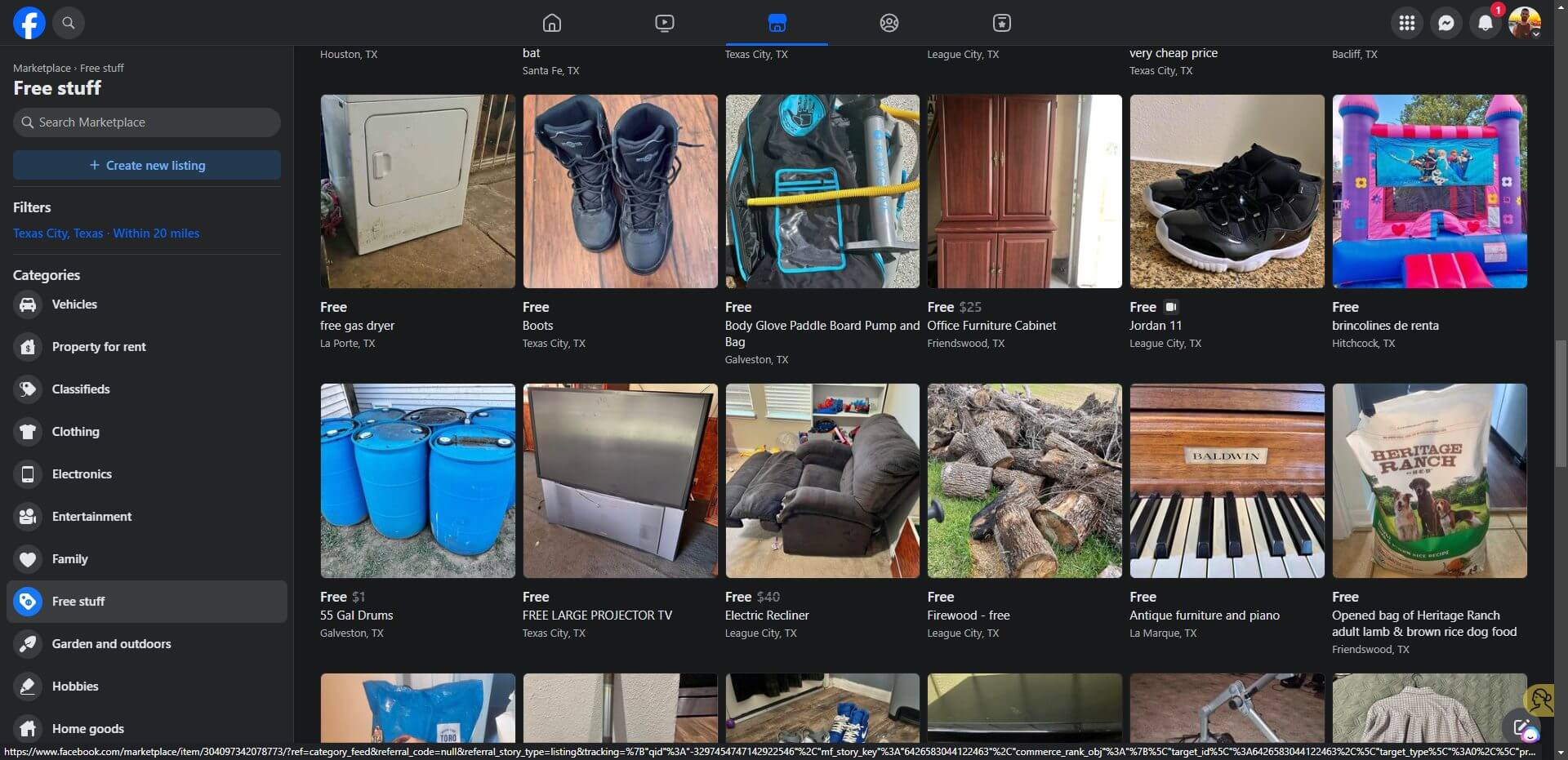
Is Facebook Marketplace Flipping For You?
For many people, flipping items on Facebook Marketplace can be a great way to make extra money. For some, it’s something they turned into a full-time income. The great news is that it requires minimal effort and overhead costs.
All you need is:
- an eye for spotting good deals
- basic knowledge of products and services
- the willingness to put in the time it takes to get your business off the ground.
However, there are challenges associated with this endeavor. For one, you must research the products you want to flip to ensure they are legitimate and marketable.
You will also need to be creative in your marketing efforts, as this type of business is highly competitive.
Who Is This Business Not For?
Do you have time you can dedicate to this business? If the answer is anything but a resounding YES, flipping stuff on Facebook might not be for you.
This business will likely be too overwhelming if you don’t have enough time to commit to researching, buying, marketing, and selling the needed items.
Researching what’s in demand and staying on top of trends takes time. You might also have to contact many people to get someone to say yes to you picking up/buying their items.
Next, learning what makes people click on your ad is a skill you must develop over time. The same applies to getting people to buy.
Facebook Marketplace Success Case Study
Here is a case study that shows you what’s possible.
Flipping on Facebook Marketplace with Financial Hustlers
Here’s an example of how someone made $1000 in 7 days on Facebook Marketplace:
The creator behind the Financial Hustlers decided to take on a week-long challenge to see if flipping items on Facebook Marketplace can be profitable. His journey shows the potential of this platform for running a side hustle.

Here’s a breakdown of his daily activity:
- Day 1: The challenge kicked off impressively as he secured four items. His initial acquisition was a Wii console bundle for $60. By selling its components separately, he made a profit of $50. His next find was a weight set from Craigslist, purchased for $250. He later sold it for $525, netting a profit of $275. He also invested in a 2DS with games for $140 and a special 3DS bundle (Black Friday Edition) for $150.
- Day 2: He bought two weight sets. The first set, which included various weight plates and a barbell, cost him $175. The second set, consisting of heavier weights, was acquired for $200. He sold the combined sets for $550, making a profit of $175.
- Day 3: A smaller flip on this day. He bought a Guitar Hero Aerosmith set for $40 and later sold it for $75, gaining a $35 profit.
- Day 4: Another modest day. He purchased 45 pounds of weight plates for $20 and flipped them for $45, pocketing a $25 profit.
- Day 5: He found a Nintendo Switch Animal Crossing Edition bundle for $200. The bundle’s value was primarily in the Switch itself, but he made his profit from the accompanying games. He sold the bundle for $320, achieving a $120 profit.
- Day 6: The final buying day. He snagged a full weight set, including an Olympic bar and dumbbell holders, for $150. He later sold the set for $350, realizing a $200 profit.
By the end of the week, he had made a total profit of $1,030.
One thing I like about this experiment is that the strategy is replicable. In fact, the creator of this YouTube channel encourages viewers to try it out for themselves. He also encourages viewers to stay informed about the market value of items.
Starting A Facebook Marketplace Flipping Business
Here’s the process to follow if you want to start this type of business.
You first go to Facebook Marketplace and search for two criteria:
- Free items
- Near me
Why pay for items when free ones are available? You also don’t want to spend money (if possible) traveling further than you need to.
If the item isn’t free, I’d advise you to try and negotiate a better price. Moreover, don’t be afraid to ask questions. Generally, outright asking someone if they’ll sell something for less than the listed price doesn’t work.
Top Items To Consider
Furniture is one of the best items to consider in this type of business. People often want to get rid of “good enough” furniture to make space for newer stuff.
The same applies to clothing. People often grow out of clothes they no longer have space for. Picking up clothes they’re giving away for free is a win-win for both parties.
Electronics are another item that can be flipped for a profit. Even if the item is partially broken, chances are that it can still be salvaged and sold for parts.
Here’s an example of a listing of a Casio Keyboard being given away for free.
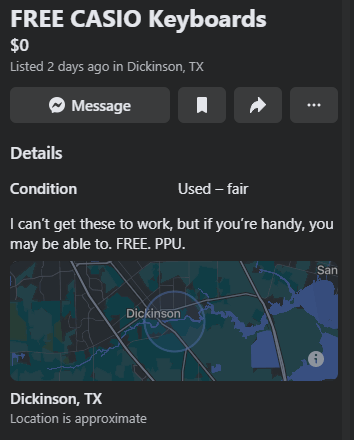
Checking the resale value
Before you contact the seller, check the resale value of similar items. You can often do a quick search on the same marketplace and find similar items that are selling for various prices.
This will give you an idea of the resale value and help you decide if you want to proceed.
Contacting The Seller
Next, it’s time to contact the seller. Time is of great importance here. Ask the seller when the first opportunity to pick up the items is.
Also, asking for additional items is a great way to get your hands on more items. Many people want to clear out their living space. Whether it’s furniture, clothes, or even appliances, it never hurts to ask.
Here’s a message I could send to the above seller (Casio Keyboard):
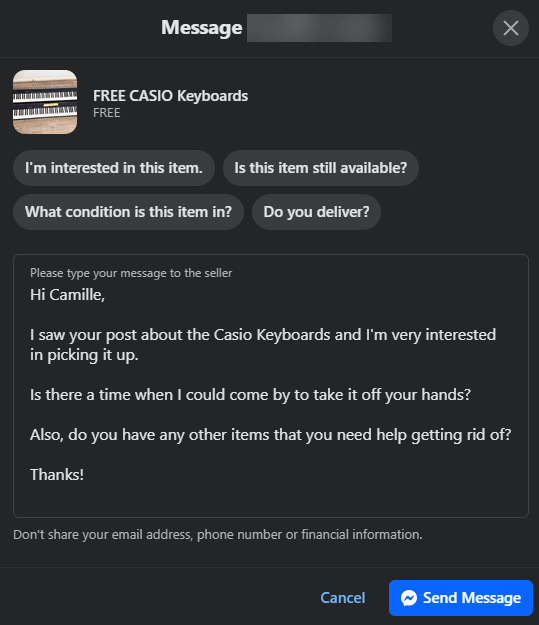
You can use the message above as a simple template for contacting someone offering free items:
Hi {name},
I saw your post about the {item name} and I’m very interested in picking it up. Is there a time when I could come by to take it off your hands?
Also, do you have any other items that you need help getting rid of?
Thanks!
Picking Up the Items
If you already have a vehicle with enough space, you can arrange with the seller to pick up the items. Be punctual and bring suitable materials for loading (such as straps or ropes).
If you don’t have a vehicle to accommodate the item(s), consider booking a van from a rental company. This will save on costs and ensure that everything is transported safely.
For those in the U.S., U-Haul has options that start as low as $19.95. This might be a cheaper option for you if the items need to be transported a long distance.
Speaking of pickup, you can also set up a profile on Angi as a handyman who can help people get rid of things. Bonus points if you can combine multiple pickups and line-up tasks for the same day.

Fixing Items
One important consideration is whether the item(s) must be repaired. It’s worth taking a few moments to assess this and obtain quotes from local handymen or furniture repair services if necessary.
Repairing furniture can add significant value to an item that might otherwise have been discarded. Refurbishment will also open up more options when it comes time to sell the item.
Relisting items
Now it’s time to be creative.
You must think like a professional salesperson, focusing on what a potential customer will get from the item. What makes your item unique or why is it of greater value than competing listings? Researching competitor listings can be helpful to get a better feel for how to present and market the item.
Having amazing-looking pictures will also help potential customers get a better idea of what they are buying. Taking pictures from all angles and including close-up shots can capture additional details.
Let’s say you’re selling a brand-name fashion bag. Here’s a bad way of listing the item:
“This is a bag, it has straps. It can hold stuff and it looks nice. Buy now!”
I know I know—no one would say that (you’d think).
However, here’s a listing that might (subjectively) be worse than that:

Not much information to go on there.
But what if instead of just stating the basics for an item, you wrote something like this?
“This stylish canvas bag features hand-stitched leather accents, and will instantly spice up any outfit. With multiple pockets to keep all your essentials organized, it’s perfect for a day out on the town or a weekend getaway. The adjustable straps ensure maximum comfort during wear while still looking great!”
In this case, you provide more details about the product and show how it can benefit the buyer. Doing so helps buyers learn more about the item and makes their decision easier. Never underestimate the power of using the right words in selling.
Here’s another example. Let’s take the Casio keyboards above and develop a description that does a good job of selling the product.

What do you think? I think we’ll be able to find a seller for this keyboard!
Key Skills To Have
The skills to have when starting a Facebook Marketplace flipping business include:
- Research: You don’t want to waste time on items people won’t pay for. Spend some time researching what kinds of things are popular right now.
- Negotiation: The key to making a profit is negotiating with people. If they are giving away their stuff, chances are others also want it. If they are selling it, you might be able to get it for less.
- Salesmanship: Once you’ve acquired the item you want to sell, it’s essential to be able to market it and convince people they should buy it. This involves taking good pictures and/or writing compelling descriptions of your items.
- Customer service: Good customer service is essential when running any business, especially within an online marketplace like Facebook Marketplace. Customers need to feel like they can trust you and that you’re willing to stand behind what you sell.
- Networking: Making connections in your local area or within the online marketplace can help you find new items to buy and resell. It’s also a great way to promote your business. Reach out to friends, family, and other people who might have items they no longer need.
The great news is that the above skills can be developed over time. You don’t have to be great to start, but you must have an open mind and a willingness to learn.
Low-Cost Business Ideas With High Profit – FAQ
What are some low-cost business ideas with high-profit potential?
Here are the key business ideas mentioned in the post above:
- Online Blogging: Think of it as sharing your thoughts or expertise on a topic you’re passionate about. It’s like having an archive of useful information based on personal experiences that others can access and use.
- Cleaning Service: Ever helped a friend tidy up their place? It’s the same idea, but now you get paid for it.
- Selling Online Courses: Remember when you taught your cousin how to bake? It’s like that, but online.
- Flipping Assets on Facebook Marketplace: It’s like garage sales but on the internet. Buy low, sell high.
How much money do I need to start a business?
It depends.
Some businesses, like blogging, can start with as little as $50 for a domain name. Others, like a cleaning service, might need a few hundred for supplies. The key is to budget and plan.
What is the profit potential of a low-cost business?
Think of profit potential like planting a tree. Initially, you might not see much. But with time, care, and patience, that tree can bear fruit.
A blog might earn a few dollars in its early days but could rake in thousands later on. Similarly, as your cleaning service gains a reputation, your client base and earnings can grow.
How do I start and grow a successful business?
Want to start and nurture a business? Start with a clear idea. What do you want to offer?
Next, understand the market. Who are your competitors? What’s your unique selling point? After you do that, you must invest time, effort, and a bit of money.
Let people know about your business. Finally, keep at it. Regularly update your blog, improve your services, and adapt to feedback.
What are the best tips for business success?
Here are some of our best tips for business success:
- Stay Curious: Always be in learning mode. Learn, adapt, grow.
- Listen to Feedback: It helps you to improve your offerings.
- Stay Committed: Every business has its ups and downs. There might be bumps but stay on the path.
- Network: Build relationships. Brad Lea says, “The more hands you shake, the more money you make”. Can’t disagree with that one.
- Manage Finances Wisely: Keep track of your money so you don’t overspend. Research and choose carefully what is worth investing in and what is not.



